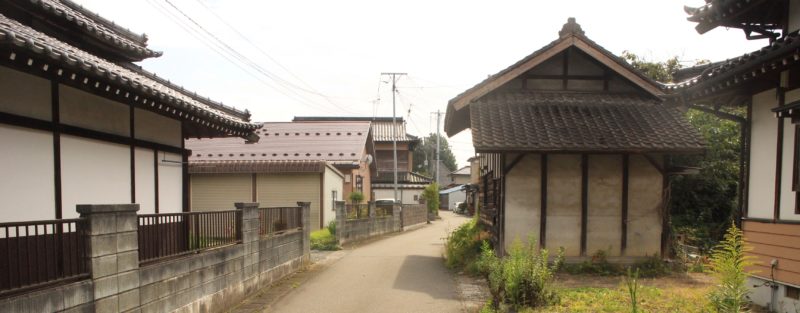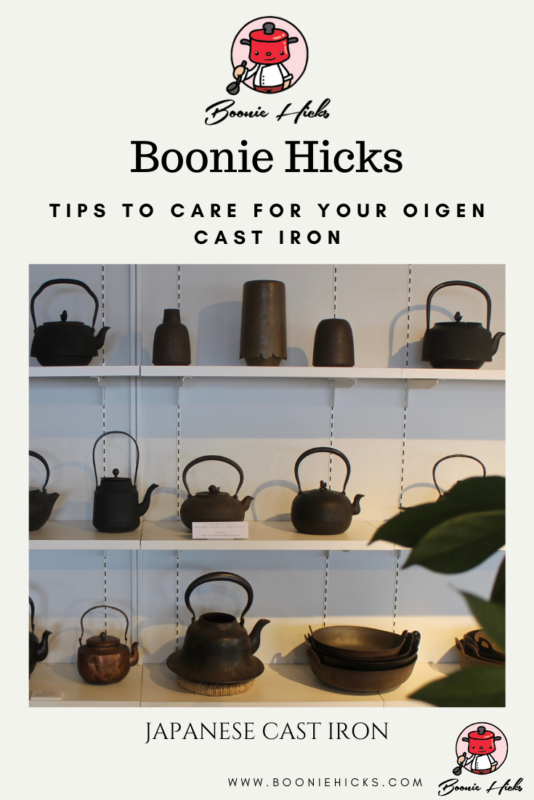Are you looking for Japanese cast iron? Then, you’ll likely come across two companies, Iwachu and Oigen. Both companies make traditional teapots, kettles, and cookware. In this article, you can learn about Oigen cast iron, its history, its products, and how to use and care for their teapot and kettles.
Table of contents
- Foundry information
- History of Oigen
- How is Oigen cast iron made?
- Oigen cast-iron products
- Use and care tips for your teapot, kettle, and cookware
- Final thoughts

Information on the Oigen Foundry
| Origins | Oigen makes its cast iron products in the Prefecture of Iwate. Only cast iron produced in this area can be called Nambu Tekki. |
| Founded | The company was initially named Oikawa Genjura Foundry and dates back to 1852. And still run foundry by the Oikawa family, who also operates the Oitomi (external link) foundry nearby. |
| Cast-iron foundry and factory shop | Horinouchi-45 Mizusawa-Ku Hadacho, Oshu, Iwate 023-0132 Japan Google maps |
| Type of casting | Most ironware is sand cast, but the company still uses traditional clay molding for some tea kettles. |
| Iron source | Oigen makes its products from iron ore sourced from Australia and is processed in Japan to ensure the Japanese standards. They also recycle products that do not pass their quality control. |
| Distribution | Oigen cast iron is available worldwide. The company partners with retailers of all sizes, from boutique shops to big online stores including Amazon. There is also a factory shop if you’re in the area. One thing I liked when I visited the shop was the showcase of traditional Tetsubins from local artisans. |
| Interior finishing | Oigen Casting Works has three types of finishes, which is right for you? 1. Uncoated interior (you’ll find uncoated interiors in Tetsubins). Great if you want to increase your daily iron intake. 2. Enameled (used in teapots). Easy to clean and nonporous. 3. Oiled (used for cookware and some kettles) Hard polymerized oil separates food and liquids from coming into contact with iron. |
| Exterior finishing | Your Oigen cast iron will have one of two exterior finishes: 1. Urushi (or Japanese lacquer gives a traditional look to Japanese teapots and kettles). 2. Oiled (method for seasoning cast iron cookware). |
| Products | Oigen has a wide product range, including teapots, kettles, trivets, Dutch Ovens, grills, wind chimes, and even protective skillet handle covers. |
History and background
Do you want a cast iron teapot or kettle made in Japan? Then, it would be best if you didn’t look past Oitomi, Iwachu, and Oigen. All three companies make good cast-iron hollowware that will last decades.

Oigen is a large-scale cast-iron manufacturer in Japan and has operated since 1852. They are located in the heart of Mizusawa, Oshu, a town in the Iwate Prefecture. This area is famous for manufacturing Nambu Tekki (southern cast iron). You can learn more about the history of Nambu/Nanbu Tekki by clicking the link.

Like many Japanese foundries, Oigen made traditional tetsubin kettles using clay molds. However, with technological advancements, they make most of their products using green sand casting. Although they still traditionally make many tetsubin kettles by highly trained artisans.
Oigen has a full line of products, such as Dutch ovens, grills, trivets, skillets, and sukiyaki bowls.

How is Oigen cast iron made?
I was lucky to look around the foundry to learn how the family-run business manufactures cast iron. My guide was Yutaro Ose, who kindly answered my questions and allowed me to take a few photos. Here’s what I learned.

Oigen is one of the larger companies that makes Nanbu Tekki. However, I was surprised by the scale of the foundry.
In every process, there are multiple checks to ensure quality. I expected the traditional method of clay molding to be very hands-on. But I didn’t expect to see the number of people needed to make sand molded cast-iron. The attention to detail is impressive.

How is your Oigen sand molded cast iron made?
| Making sand molds | First, sand is mixed with water to create the desired moisture content. Although there is a machine readout, experts can tell when the molding sand is ready by touch. The amount of water needed changes daily, depending on humidity. |
| Making ironware | Before pouring iron into the prepared molds, the molten iron is checked to see if it has reached the desired temperature. |
| Quality control | The staff removes iron from the sand molds when the ironware is cool enough. And the sand remaining on the surface of the ironware is removed and checked for imperfections. |
| Rust prevention | Oigen ensures your teapot or kettle is rust-resistant by heating the ironware to extreme temperatures in a kiln. This reheating provides an oxidized layer to the surface of the ironware. This layer is less likely to rust. |
| Enameling, lacquering, and oiling. | The most popular method for lining cast iron teapots is enameling. Enamel is nonporous and easy to clean. However, cookware, teapots, and kettles may have a natural oil polymer coating. Lacquering is the most popular method for protecting the exterior surface of cast iron teapots and kettles. And it gives a very pleasing shiny appearance. However, an oil seasoning is used on the exterior of the company’s cookware range. The matte black finish is also popular on kettles and teapots. |

Oigen Cast Iron Products
If you want to see what products Oigen has available on Amazon (affiliated link). You can also visit their product page here (non-affiliated link). However, I don’t think they directly sell internationally.

Palma teapot
Jasper Morrison, a renowned English designer, designed this Nanbu iron kettle. The design for this particular teapot has both style and practicality in mind.
The lid has a simple yet stylish knob. It’s a modern take on the traditional Japanese teapot. However, the Palmer teapot is not cheap and is out of my price bracket. But its design is beautiful, and owners can proudly display this kettle when not in use. It would look terrific in both modern and traditional kitchens. It’s available on Amazon if you want to check it out (affiliate link).

Oigen Maromi Arare kettle
You will love this is a classic teapot we all know and love. With a pebbly finish on the outside, it’s a real cutie. Yes, it’s available on Amazon through this link (affiliate link). It holds about a quart of water and has a good star rating.
This teapot has a thin layer of polymerized seasoning to prevent rust. Because of the coating, you can clean the inside lightly. However, I recommend not cleaning it like a regular kettle to add a calcified protective layer
Blue egg-shaped teapot
Colored teapots are very popular in Japan. In my workplace, many of my Japanese co-workers have colorful small teapots. They say small teapots are very Kawaii (cute). This teapot is perfect for Sencha tea leaves and features a wide infuser, so it’s easy to clean. Here’s the link to Amazon (affiliate link). I guarantee this teapot will make you smile.
Sukiyaki Pan
A cast-iron pot is a perfect vessel to cook your traditional Japanese dishes. It has deep sides similar to what you would find on a brasier. But a Sukiyaki pan is seasoned like your cast iron skillets. Like other cast-iron cookware, this pan evenly distributes heat once heated.
The Japanese like to use this type of pot in the cooler months. It is the go-to pan for the traditional dish of Sukiyaki. Here’s the Amazon (affiliate link) link to start cooking Japanese dishes. This pot is suitable for both standard and IH stovetops. .
Oigen Cast Iron Use & Care
Are you wondering how to use and care for your cast iron kettles, teapots, and kitchenware? Here are some tips.

Cast Iron Kettles (Tetsubins)
These kettles are for boiling water and not to brew tea. Before using your tetsubin for the first time:
- Remove the lid.
- Fill the kettle with water and boil the water for approximately eight minutes.
- Discard the water.

Care Tips
To care for your tetsubin, follow these tips:
| After use | After using your kettle, discard the remaining water and thoroughly dry the inside and outside. Turn it upside down and allow it to dry with the lid off. |
| White spots | You’ll notice some white spots on the inside of the kettle with use. The spots are mineral buildup, and it is normal. Just keep using your kettle as usual. |
| Prevent rust | Never let water sit inside the kettle after use. Leaving water in a tetsubin will cause it to develop rust. |
| Storage | Store your kettle in a dry area. Displaying your kettle is a great idea because it will have a lot of air circulation. |
Cast Iron Teapots
Please use your Oigen teapot to steep tea and not boil water. Before using your teapot for the first time:
- Remove the tea strainer.
- Fill the inside with water and gently wash it with a soft sponge.
- Dump the water.
You are now ready to use your Oigen teapot. Follow the instructions for brewing your favorite tea. Remember, teapots are to be used for brewing tea only. You must boil water in a separate kettle.
Care Tips
Here are some tips to help you care for your Oigen teapot.
- After use, gently wash the inside of the teapot and the tea strainer with a sponge.
- Don’t use detergents, scrubbers, or harsh chemicals to clean your teapot. It could damage the lining.
| After use | Gently wash the inside of your teapot with a soft sponge if your teapot has an enamel lining. |
| Washing tips | Don’t use detergents, scrubbers, or harsh chemicals to clean your teapot. It could damage the lining. |
| Storing | Gently dry the teapot with a soft cloth after every use. Turn it upside down and store it in a cool, dry place. |

Oigen Kitchenware care
| Wash | Before using cast iron for the first time, wash the iron out with water. |
| Preheat your cookware | Preheat your pan on low to medium heat to avoid warping your cast-iron cookware. |
| Fry vegetables peelings to season your pans | When using your cast-iron pans for the first time, fry some vegetable peelings (throw them out after). Frying vegetable scraps will remove any factory oils and season your pan. |
Like with Oigen’s famous teapots, never use harsh detergents or scrubbers on cast iron pans. Also, make sure you completely dry your pan after every single use to prevent rust from forming.
Final thoughts
Oigen cast iron has thrived despite wars, earthquakes, and other setbacks. The company flourishes thanks to the dedication and work ethic of the many local artisans who make Oigen’s quality ironware. Oigen products are great for any kitchenware collection.









Hi, I am from Malaysia. I am interested in a Japanese cast-iron oven for baking bread and skillet for small stir fry. I also read that Le Creuset is actually made in China. How do we know if it’s fake or real?
Hi Nancy
If you’re interested in a Japanese Dutch Oven then Oigen has a large selection of ovens available. They also make a skillets if you’re interested. Oigen ironware tends to be heavier than other brands so check the weight carefully before you purchase.
Le Creuset ironware is made in France and should be cast thinner than other brands. The ironware will be free from imperfections, but I still recommend you buy from a reputable retailer if you are in any doubt of authenticity.
Hope this points you in the right direction.
Happy cooking